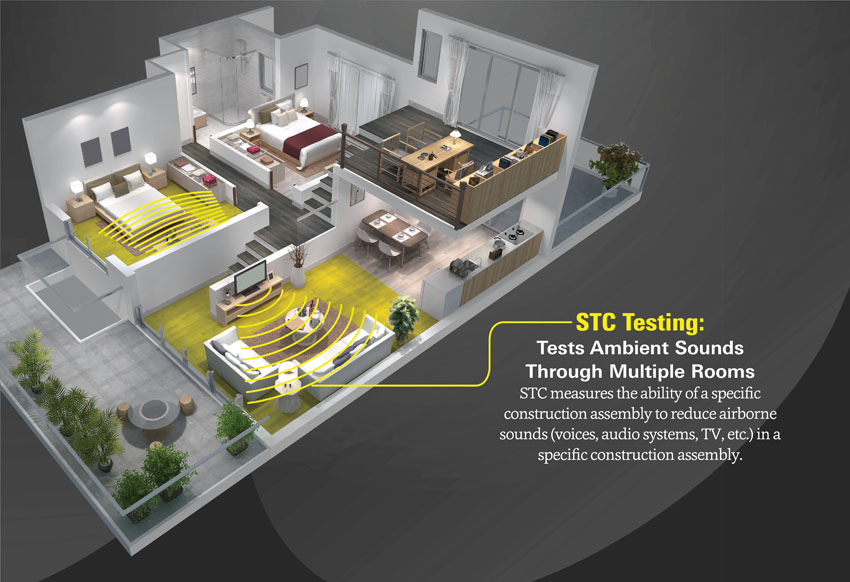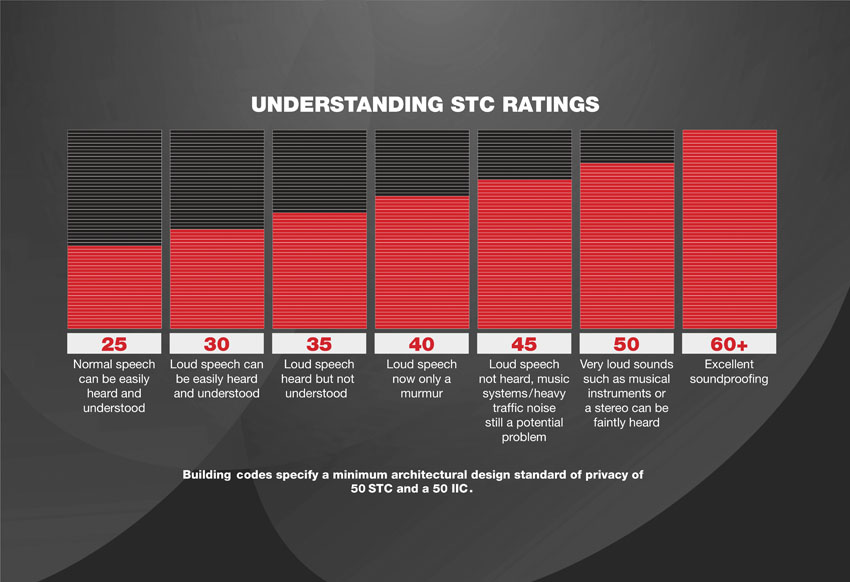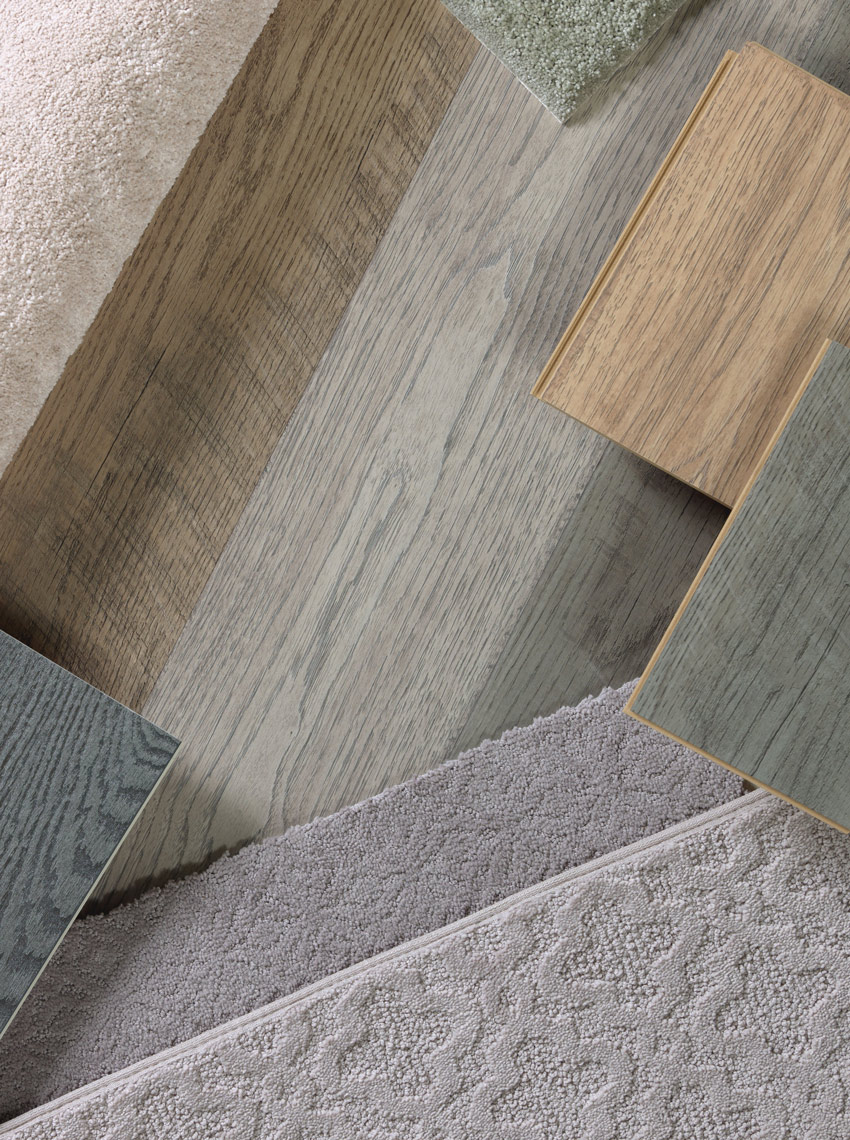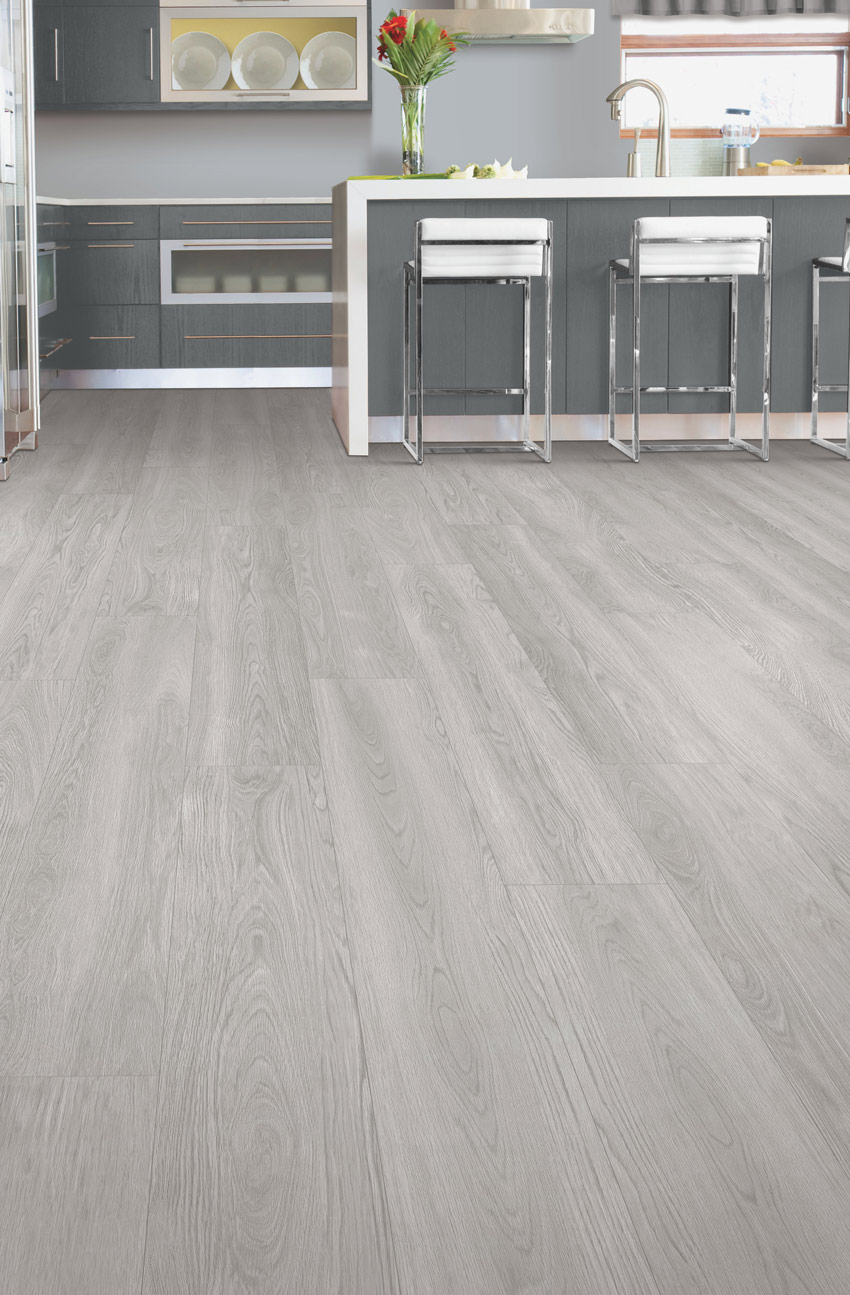The Quiet Multifamily Home
STC measures the ability of a specific construction assembly to reduce airborne sounds (voices, audio systems, TV, etc.). The assemblies are tested according to ASTM E336 and ASTM E90.
The assemblies are tested according to ASTM E336-19: Standard Test Method for Measurement of Airborne Sound Attenuation between Rooms in Buildings.
STC Tests Airborne Sounds

Image courtesy of Mohawk Flooring
Sound transmission class (STC) testing measures the ability of a specific construction assembly to reduce airborne sounds (voices, audio systems, TV, etc.).
According to ASTM, “The main part of this standard uses procedures originally developed for laboratory measurements of the sound-transmission loss of partitions. These procedures assume that the rooms in which the measurements are performed have a sound field that reasonably approximates a diffuse field. Sound-pressure levels in such rooms are reasonably uniform throughout the room, and average levels vary inversely with the logarithm of the room sound absorption. Not all rooms will satisfy these conditions. Experience and controlled studies have shown that the test method is applicable to smaller spaces normally used for work or living, such as rooms in multifamily dwellings, hotel guest rooms, meeting rooms, and offices with volumes less than 150 cubic meters.”
The International Building Code (IBC) calls for a rating of 50 in the test laboratory for both IIC and STC, and a rating of 45 when tested in the field. The higher the number, the quieter the room.
The assemblies are tested according to ASTM E-90: Standard Test Method for Laboratory Measurement of Airborne Sound Transmission Loss of Building Partitions and Elements.
According to ASTM, “This test method covers the laboratory measurement of airborne sound-transmission loss of building partitions, such as walls of all kinds, operable partitions, floor-ceiling assemblies, doors, windows, roofs, panels, and other space-dividing elements.”
Following is a breakdown of the test results.
- STC-ICC 70 is just about soundproof.
- STC-ICC 60 is superior soundproofing.
- STC-ICC 50 is acceptable soundproofing according to the IBC.
- STC-ICC 40 is soundproofing that is below most codes.

Image courtesy of Mohawk Flooring
While IIC and STC test results can show how individual products affect the soundproofing of the assembly, note that the results are for the entire assembly and not just the product. When a manufacturer indicates IIC and STC test results, the exact assembly tested will be described. Acoustical performance differs over various floor coverings, such as concrete and open-web wood truss floor/ceiling assemblies.
A little understood fact is that a higher IIC/STC rating is not always better above a certain point. Some specifiers indicate a general rating to satisfy their preference without having understanding of IIC/STC ratings data. Some flooring companies have taken time to understand IIC/STC ratings on their flooring products to help architects, designers, and specifiers make a sound decision. The human ear cannot distinguish much difference between an IIC of 55 versus an IIC of 62 on an open-web truss.
SOUND RATINGS FOR VARIOUS FLOOR PRODUCTS AND UNDERLAYMENT PADS

Image courtesy of Mohawk Flooring
Different flooring choices will have different IIC and STC ratings.
Various flooring choices generate different IIC and STC ratings. Those are enhanced with sound-blocking and sound-absorbing underlayment pads.
Click here to hear the differences when underlayment padding is added.
Let’s consider luxury vinyl tile (LVT) and planks (LVP), luxury sheet vinyl, laminate, and carpeting individually. But first, it is helpful to understand common flooring terminology.
Flooring Terms

Image courtesy of Mohawk Carpeting
When discussing flooring, it is helpful to understand several terms, including gauge, millimeters, ounces, and mils. Following are definitions.
- Gauge is used to measure the thickness of sheet vinyl flooring; for example, 65 gauge equals 0.65 inch.
- Ounce is the weight of the carpet’s fibers in 1 square yard of flooring.
- Millimeters are used to describe the thickness of flooring.
- Mils are one-thousandth of an inch, or 0.001 inch. One mil also equals 0.0254 millimeter and is used to measure the wear layer or protective-coating thickness in flooring.
LUXURY VINYL FLOORING

Photo courtesy of Mohawk Carpeting
It is not the same vinyl from decades ago.
Vinyl flooring is a prime example of a product whose current state of quality is vastly improved from selections available decades ago. Today’s luxury vinyl features some of the most innovative, versatile, and high-performing flooring available. Premium vinyl flooring offers the richness and texture of more expensive natural materials, such as hardwood, ceramic tile, and stone, without maxing out a multifamily unit budget. It is offered in tile, plank, and sheet formats.
Luxury vinyl is strong but soft underfoot, maintaining a comfortable temperature in all seasons. But not all luxury vinyl products are equal. Higher-quality vinyl flooring resists the damaging impacts of heat and sunlight, maintaining its shape and stability even at temperature extremes. Vinyl is waterproof, which makes it suitable for kitchens or other high-traffic areas such as living rooms or dens. Higher-quality LVT), LVP, and sheet vinyl includes a durable, protective top layer that resists scratches, dents, and stains from family pets. These offer high-end looks without the high-end price tag, and there is generally a selection of hardwood and stone visuals lend elegance to any room.
Some LVPs include a locking system that keeps planks tightly in place and eliminates adhesive costs. That means they install quickly for move-in-ready floors. Some higher-quality LVPs have no-polish maintenance, which would appeal to buyers and building owners.
In terms of sustainability, look for products that are FloorScore Certified, CARB II Certified, and may contribute to or comply with LEED credits.









